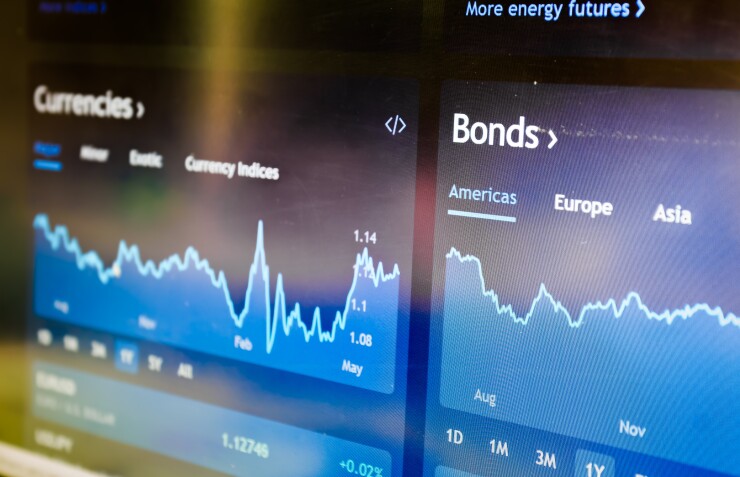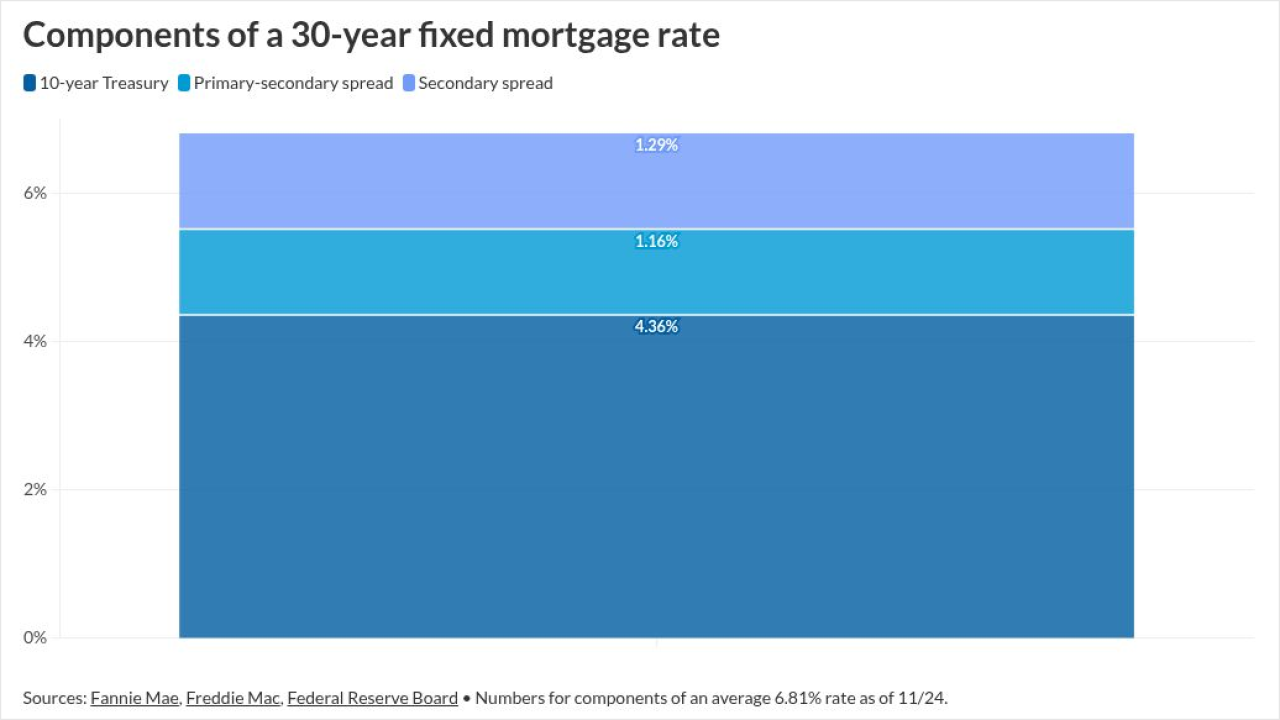As fears of rising inflation grow, equities pull back from all-time highs, and the 10-year Treasury yield rises, analysts are looking for investment opportunities in fixed-income assets.
Investors should expect that the fiscal policy loosening proposed by the incoming U.S. administration could potentially act as a dampener on further Federal Reserve interest rate cuts in 2025, according to Toronto-based investment managers Ninepoint Partners. That strategy would leave the interest rate steady at around 4%. Rising inflation and a deteriorating fiscal situation would generate headwinds for long-term bond prices, according to Ninepoint's 2025 Market Outlook report.
The recent 100 basis-point yield rise in the 10-year Treasury to 4.6% is reflecting investor demand for higher compensation as they grapple with uncertainty about the future direction of the economy and elevated fiscal policy uncertainty, said Chip Hughey, managing director of fixed income at Truist. The latter, known as Term Premia, is responsible for more than 80% of the rise in yields over the past four months, Hughey said.
However, well-chosen fixed-income products can provide stability in an uncertain environment and are well-positioned to diversify portfolios should there be some volatility in risk assets, the Ninepoint report said.
Choosing wisely
Bonds are poised to perform well in 2025, said Gene Tannuzzo, global head of fixed income at Columbia Threadneedle Investments. He sees them regaining their critical role as portfolio diversifiers and resuming their important role as shock absorbers in a portfolio that includes stocks and credit risk.
Best performers will be high-quality bonds, particularly mortgage-backed securities and municipal bonds, Tannuzzo said.
"These sectors, which are already starting from attractive yield levels, are well-positioned to deliver strong price returns as rates decline," Tannuzzo said. In the event of an economic hard landing, high-quality and longer-maturity fixed-income securities would benefit from the greater demand for safe-haven assets, he said.
Columbia Threadneedle is taking a slightly more defensive stance on corporate credit. Tannuzzo expects balance sheet weakness to lead to higher default rates in the high-yield bond market, particularly in telecom and media.
J.P. Morgan Securities prefers credit card AAA ABS bonds, backed by prime to super-prime bank-originated receivables, as they offer "stellar credit performance with ample liquidity," the bank said in its U.S. Fixed Income 2025 Outlook Overview report. AAA consumer credits are significantly enhanced with the excess spread for bankcards, providing a sizeable buffer that is resilient even against material economic weakening. The bonds also have hard protection through subordination and overcollateralization, J.P. Morgan said.
Seeing the bright side
There is also room for positivity on both CLOs and consumer debt, according to Tracy Chen, a portfolio manager at investment management firm Brandywine.
"CLOs for short-duration high-yield credit are doing well, as are short-duration asset-backed securities," Chen said. "Fiscal spending benefits businesses, so I don't see a big default risk for CLOs. Household net worth is robust because of the stellar performance of the U.S. housing and stock markets."
Chen thinks higher-yield, floating-rate bonds should do very well in the current market. She is positive on auto loan ABS, where solid underwriting has led to low default rates. "The short duration minimizes interest rate risks, and, with healthy used car prices, even if lenders do experience auto loan defaults, they can get a very good recovery on car loan defaults," she said.
Chen particularly likes subprime auto loans from stronger issuers such as Santander and West Lake which have had very healthy deal structures.
"The interest rates are in the double digits for subprime auto loans, which is out of proportion to the actual risk," she said. "By comparison, prime auto loans offer too low a yield."
Chen also favors floating-rate credit risk transfers (CRTs) from Freddie Mac and Fannie Mae. The U.S. housing market has been very strong, with losses under 1%, she said. "So, investors in CRTs profit hugely and have been getting a 20% return for the past two or three years."
Commercial viability
CMBS is another sector with opportunities, Chen said, as it has been performing really well with BBB-rated CMBS funds returning over 20% in 2024. These returns are mostly for newly issued bonds which have less exposure to office properties and were priced very cheap last year due to negative market perceptions.
"Last year's CMBS issues were mainly for industrial warehouses and some retail properties, but not for obsolete retail malls," Chen said.
Chen lists best performing CMBS sectors as multi-family residential rental properties, Class A offices with strong sponsorship, newer retail malls, and data centers, where the "AI explosion" has driven a data center construction boom.
Mike Nowakowski, head of structured products at investment management firm Conning, also sees value this year in ABS, CMBS and RMBS. Spreads have compressed, however, he pointed out, and, although ABS and RMBS are still favored, he is looking for higher yields in longer duration bonds.
"In order for us to go even further out the duration spectrum, we'd like to see 10-year treasuries get closer to 5%," Nowakowski said. "With this backdrop, we like longer-duration RMBS, and we also believe that we'll be able to buy Agency MBS at cheaper spread levels than where they are currently." Others are also cautious about Agency MBS at current spreads. "Spreads have tightened to what was last seen in early 2022," said Ralph Axel, U.S. strategist at BofA Securities. "So, our MBS team has switched from neutral to underweight. We had a similar story in corporates."





